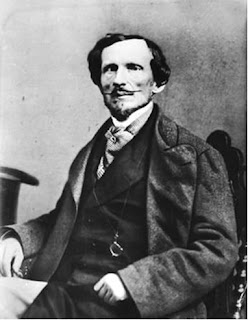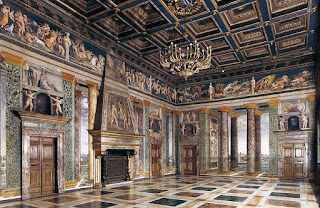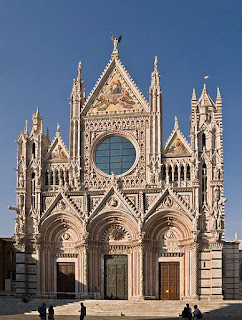Prime minister and inventor of modern Chianti wine
 |
While not tending to his ancient vineyards,
Bettino Ricasoli was twice prime minister |
The politician and winemaker Barone Bettino Ricasoli was born on this day in 1809 in Florence.
Ricasoli, who is considered one of the driving forces of the Risorgimento alongside
Giuseppe Mazzini, Count Camillo Benso of Cavour, Giuseppe Garibaldi and others, succeeded Cavour as prime minister in 1861, the second person to hold the office in the new Kingdom of Italy.
After withdrawing from politics, he concentrated on the family vineyards around the
Castello di Brolio in the Tuscan hills between Siena and Arezzo, seat of the Ricasoli family since the early 12th century.
It was there is 1872, seeking to create a wine with universal appeal, that he developed the formula for
Chianti wine that is still used today, made up of 70 per cent Sangiovese grapes, 15 per cent Canaiolo and 15 per cent Malvasia bianca.
Today
Barone Ricasoli - the oldest wine producer in Italy and the second oldest in the world - is the largest winery in the Chianti Classico area, with 235 hectares of vines and 26 hectares of olive groves in the area around
Gaiole and
Castelnuovo Berardenga.
Bettino was the son of Baron Luigi Ricasolo and Elisabetta Peruzzi, who came from a family of Tuscan bankers. He attended the
Collegio Cicognini, the oldest school in
Prato, and spent two years travelling around Europe with his personal tutor. He was orphaned by the age of 18 following the deaths of both his parents, inheriting the castle and the estate but finding it to be heavily in debt.
 |
Vines fill most of the slopes surrounding the ancient Ricasoli
family seat at Castello di Brolio in Tuscany |
Decreed to be of age by the Duke of Tuscany, and therefore the legal owner of the castle and its vineyards, he quickly enrolled at the
Accademia dei Georgofili in Florence in order to acquire the agrarian and financial skills he needed to run the business successfully. He managed to save it from collapse, helped by his marriage to Anna Bonaccorsi, the daughter of a noble landowner from Tredozio in the Tuscan Romagna, who brought with her a considerable dowry.
A follower of patriotic political philosophers such as Cesare Balbo and Massimo d’Azeglio, Ricasoli he became politically active in 1846, urging
Leopold II, the Grand Duke of Tuscany, to make various liberal reforms. The following year, he founded a newspaper, La Patria, with a mission to define “the constitution of Italian nationality”.
In 1848 he was elected
gonfalonier (mayor) of Florence after Leopold authorised the establishment of a Tuscan constitution. He encouraged support for Piedmont-Sardinia against Austria in the First Italian War of Independence.
 |
Barone Ricasoli's
chianti is renowned |
However, after Leopold was overthrown by the radical democrats Giuseppe Montanelli and Francesco Guerrazzi, who proclaimed a new republic, he reclaimed power only after turning to the Austrians for help, which so disgusted Ricasoli he abandoned his political career and exiled himself to Switzerland.
When he returned to the Castello di Brolio he took a circuitous route to avoid Florence, so that he would not have to set eyes on the occupying Austrian troops.
Ricasoli stayed out of politics until 1859, after the Second Italian War of Independence achieved its goal, when he was appointed minister of the interior in Cavour’s government of Tuscany, promoting the union of Tuscany with Piedmont, which took place in March 1860.
Elected to the Chamber of Deputies of the new Italian government in February 1861, he succeeded Cavour in the premiership in June.
As prime minister he admitted the Garibaldian volunteers to the regular army, revoked the 30-year exile of Mazzini for his membership of an illegal political group, and attempted - unsuccessfully - a reconciliation with the Vatican, with whom the new kingdom was still at odds.
He resigned in 1862 but returned to power in 1866. On this occasion he refused Napoleon III's offer to cede Venetia to Italy on condition that Italy gave up their Prussian alliance, and reached a compromise with the Vatican only for the Chamber to reject it, upon which he resigned again and withdrew from politics for good.
He died at the Castello di Brolio in October 1880.
The Ricasoli name was sold to a multinational conglomerate in the early 1970s but reacquired by the Barone’s grandson, also called Bettino. The business is now run by his great-grandson,
Francesco.
 |
Bettino Ricasoli turned the Castello di Brolio into a kind
of English-style neo-Gothic manor house |
Travel tip:
The impressive
Castello di Brolio, which sits on top of a hill 11km (7 miles) south of Gaiole in Chianti, dominates the surrounding countryside. Even though it is closer to Siena, just 20 km away and visible on a clear day, the castle has always been under the influence of Florence and was for many years used as a strategic outposts. As a result, it has been destroyed several times. The castle of today is partly the reconstruction ordered by Bettino Ricasoli in 1835, when he commissioned the architect Pietro Marchetti to modify the castle according to the taste of the Gothic revival, a romantic movement originating in England, transforming it from a fortress into something closer to an English manor house, with Tudor-style windows and crenellated turrets. Parts of the house, the Renaissance gardens and the English woods are open to the public. Inside the castle, it is possible to visit the Chapel of San Jacopo and the crypt with the family tombs and a small museum housing the Ricasoli collection.
Hotels in Gaiole in Chianti by Booking.com
 |
The Via Bettino Ricasole is a broad street, almost a
piazza, in the centre of Gaiole in Chianti |
Travel tip:
The beautiful small town of
Gaiole in Chianti, about 40km (25 miles) southeast of Florence, basks in the enviable accolade of being named at number one in a list of "Europe's Most Idyllic Places To Live" by Forbes magazine. The town is a perfect base for visiting the many castles in the area, such as the Castello di Meleto, the Castello di Spaltenna and the Badia Coltibuono, a fortified monastery. The town hosts many events connected with the wine industry plus, every March, a professional bicycle race is held, known as Strade Bianche.
























